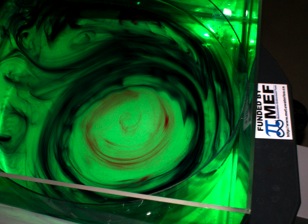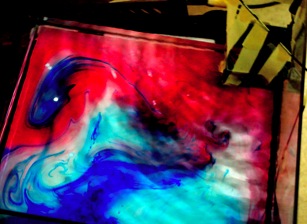The effects of rotation form the second canonical feature of naturally occurring fluids (density stratification is the first). In a rotating laboratory tank these effects can be illustrated rather clearly. In the picture on the left a computer fan blows on the surface of a fluid inducing a variety of small scale turbulent motions (upper right hand corner near the yellow arrow). A dropper full of red food colouring has been added into this region and has spread into a large, reddish cloud (pink arrow). However, rotation induces a cascade of energy to larger scales and this can be evident from the large scale blue eddies that result from an eye dropper of blue food colouring injected into the bottom left corner. The blue-dyed water is gradually pulled toward the turbulent red-dyed water through the process of entrainment. However, instead of a mixing of red and blue water on small scales, the rotation leads to the generation of large vortices, or eddies, that persist for a long time.
In the picture on the right a small stick was used to mix the tank for a few seconds and then the fluid was allowed to evolve for ten seconds or so before dark-dye was dropped in. In the picture it can be seen that a very large eddy has formed occupying nearly a quarter of the tank. The dye itself makes “walls” all the way through the fluid and these sometimes exhibit small, fine scale features.
On a rotating planet like Earth energy is injected into the atmosphere on a variety of scales. Since the rate of rotation of the planet is quite slow only large scales, like those of weather systems, are strongly influenced by rotation. However, when rotation does dominate strange phenomena like flow ALONG lines of constant pressure (or geostrophy) results. Incidentally, geostrophy is the reason why weather reports show pressure lows (cyclones) and highs (the flow is around these lows or highs). Indeed, the image above on the right has a striking resemblance to photos of cyclones from space.
Rotating Fluids








